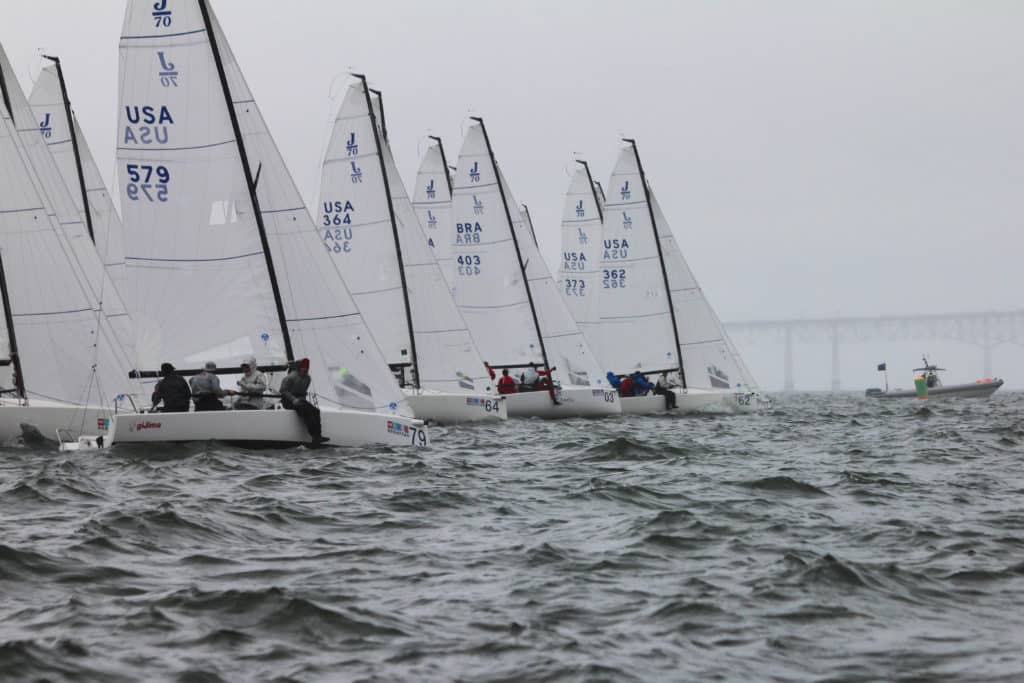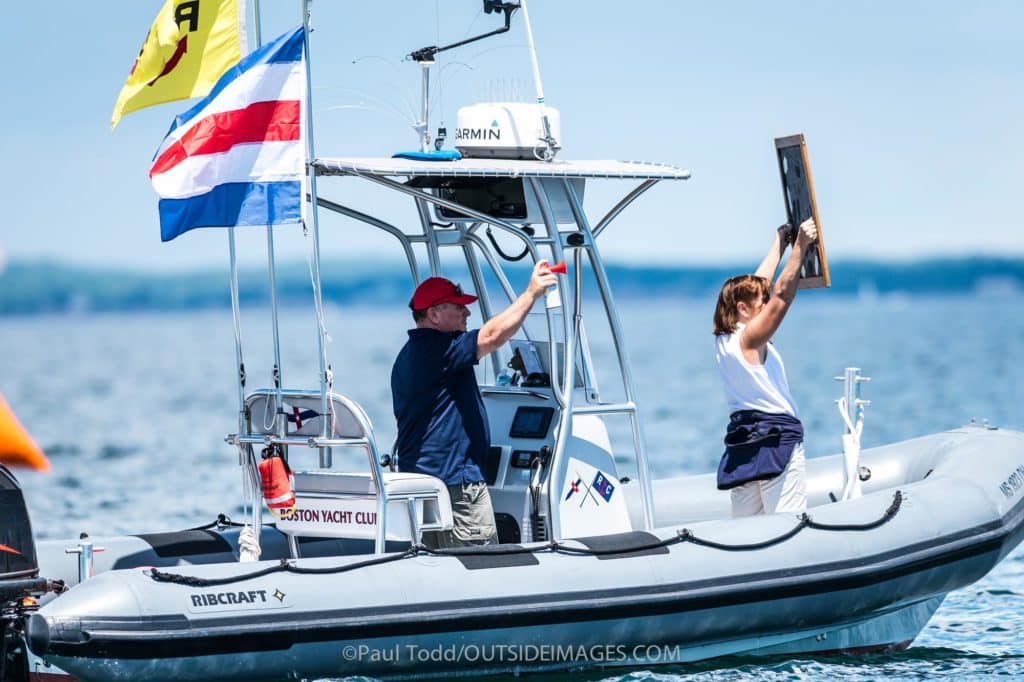
Many articles have been written about what to do before the first start of the day, and while most sailors have a basic idea of what they need to accomplish, laziness or tardiness often get in the way. If you regularly find yourself unprepared or late to the start, get motivated and get to the racecourse 45 minutes to one hour before the first gun. The more “intel” you collect before the first start, the better off you’ll be.
Once you’re on the racecourse, there are three essential things you must do: make sure you’re going fast, figure out the wind, and research the starting line.
Step 1: Gather your wind readings
Skip Whyte, my Olympic 470 coach for many years, often said that, on any given race day, there are different waves of tuning groups. The best sailors get out early and sail upwind before the mid-fleeters get to the course. If you want to win, you need to get out early and join the first group. While your team is sailing upwind and tweaking sails and rig for speed, your tactician should be figuring out the wind pattern.
The key is to watch the compass and determine a range of headings on each tack. For example, on starboard you may be sailing between 220 and 240 degrees, and on port you may be sailing 310 to 330. The wind is shifting through 20 degrees. You should also try to determine the timing of the shifts. It’s not an exact science because the wind changes often, but getting the feel for a pattern will help you make educated decisions while racing. Once you have a feel for the pattern, note the true-wind direction by finding the midpoint of all your headings. In this case, it’s 275 degrees. The tactician should also be looking around for other important tactical factors, such as current, potential geographic shifts, and varying wind conditions across the racecourse.
Step 2: Find your fast settings
When tuning up with the good teams (or a designated tuning partner), compare your relative height and speed. In general, if you’re pointing well but not going forward, make your sails flatter. If you have speed but no height, make the sails fuller and tighter leached, especially the main. If you’re lower and slower, something, or many things, are off. Make sure you’re set up according to your sailmaker’s tuning guide, experiment with different settings, and ask your tuning partners how they’re set up if they’re beating you.
Once the first tuning group reaches the top of the course, its time to go downwind. If you determined you needed to change the rig, now is a good time to do so. While sailing downwind, try different angles and techniques to figure out what is fast for the conditions. When you’re about halfway down the run, start looking for the second wave of boats tuning upwind. Find a preferred competitor, douse your kite early enough to get your boat reset for sailing upwind, and join them. Now test what you learned during the first tuning session and continue watching the compass and looking around.
Over the course of your second lap, you’ll become much more comfortable with your boatspeed and the wind patterns. If you’re sailing a hiking boat, this pre-race tuning also helps your body get warmed up and ready for action. The benefit of tuning before the race is it allows you to gain confidence in your settings and boatspeed, freeing you up to look around while racing. Unprepared sailors spend a lot of energy with their head in the boat trying to go fast, and their tactics suffer as a result.

Step 3: Research the starting line
Once you’ve tuned twice and collected course data—headings, current, and pressure differences—it’s time to take a breather. Drink water, eat a snack, and make any final tweaks to the rig. It’s also a good time to process the data you’ve collected and start building your game plan. If you got to the course an hour before the start, you should have about 15 minutes left. Start monitoring the race committee.
Once the committee sets the line, go back to work. It’s important to do more starting-line research than you think you should. Truly understand the whole “starting box,” as match racers call it. The starting box is the area defined by the laylines to the pin and boat ends and the actual starting line.
To get a line sight, sail to one end of the line, on the side opposite the land, and sight through the race committee flag, picking out an object on land—a building or tree, for example—that’s in line with both ends. Then, run the line using this sight to get a feel for what it looks like to be right on the line. The longer the line is, the greater the illusion you’re on the course side when you’re actually not. This is especially true in the middle. (Paul Elvström says that, because of this illusion, when starting in the middle of the line, he makes himself feel like he’s half a length over.) Get used to the feel of being on the line and trust the sight. If there’s no line sight available, use a compass heading to run the line. Find the heading by luffing up to one of the ends, inside the line, then aim at the other end to get a compass direction. Run the line sticking to the compass direction to keep you on the line. Run the line three times, looking back and forth the whole time.
During one of your runs, time how long it takes to sail from one end to the other. This will help you position your boat on the final approach. This is a great assignment to give to a crewmember with little to do.
Next, find the boat and pin laylines. You must start in between them (inside the starting box), and if you start near an end, the laylines play a big part in your strategy. To find them, set up a few lengths off the committee boat end of the line (30 to 40 seconds away) and head up on a closehauled course on what you think is the layline; do the same with the pin layline. If you’re off, do it again.
Top match racers check their starting laylines over and over again before the sequence, especially at the end at which they plan to start. This drill also helps you practice heading up (which you do in the last few seconds of the start). Plus, every time you reach closehauled, it allows you to track the wind by checking your compass angle. The shiftier it is, the more beneficial the drill.
During your starting-line research, put the bow into the wind a few times to check the line bias and to track the true-wind direction. I recently sailed the Championship of Champions and witnessed Jud Smith doing this more than anyone I’d ever seen. Jud and his daughter Lindsay won the practice race and first two races of the championship, and they did more wind shots than anyone before each start.
Step 4: Double-check before the countdown
Now that you’ve completed your research, you should have a great understanding of the starting box. Do a brief upwind sail again to see if anything has changed. Check your compass again and make sure the boat still feels right for the conditions. When heading upwind, observe your angle compared to the line. Visualize how the fleet will come off the line at that angle and factor that into your final game plan. Your angle off the line should correspond to the favored-end research you did. If not, then there’s either been a shift, or the committee moved the line.









